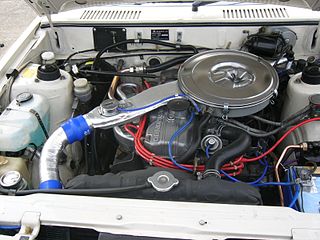The Mazda B-series is a small-sized, iron-block, inline four-cylinder engine with belt-driven SOHC and DOHC valvetrain ranging in displacement from 1.1 to 1.8 litres. It was used in a wide variety of applications, from front-wheel drive economy vehicles to the turbocharged full-time 4WD 323 GTX and rear-wheel drive Miata.

The Mitsubishi Astron or 4G5/4D5 engine, is a series of straight-four internal combustion engines first built by Mitsubishi Motors in 1972. Engine displacement ranged from 1.8 to 2.6 litres, making it one of the largest four-cylinder engines of its time.

The Mitsubishi Sirius or 4G6/4D6 engine is the name of one of Mitsubishi Motors' four series of inline-four automobile engines, along with Astron, Orion, and Saturn.

The 6G7 series or Cyclone V6 engine is a series of V6 piston engines from Mitsubishi Motors. Five displacement variants were produced from 1986 to 2021, with both SOHC and DOHC, naturally aspirated and turbo charged layouts. While MIVEC variable valve timing has also been implemented in some versions the 2.5, 3.0, and 3.5 L versions were also available with gasoline direct injection. This engine has been the flagship powerplant of the company except when they briefly built a V8 in 1999–2001. The staple of their high-end sedans, it was given twin-turbos for the Mitsubishi GTO, and became the most powerful car ever built by the company at the time.
The Hyundai Alpha series is a multi-valve gasoline inline four-cylinder engine family comprising 1.3, 1.4, 1.5, and 1.6 L naturally aspirated versions and a 1.5 L turbocharged version. Introduced in 1992, this was Hyundai's first engine designed entirely in-house and was the first indigenous South Korean engine design. Design objectives were to provide high performance and good fuel economy with excellent durability at a reasonable cost.
The Hyundai Sirius engine was the company's first larger inline-four engine, with displacements from 1.8 L to 2.4 L. It is a license-built Mitsubishi construction. This engine is no longer used by Hyundai.

The Hyundai Delta family is the company's smaller V6 engine, ranging from 2.5 to 2.7 L. Both share the same 75 mm (2.95 in) stroke and both are DOHC designs.
The Hyundai Sigma engine is a series of V6 piston engines from Hyundai Motor Company, based on the Mitsubishi 6G7 engine. The Sigma engine family began life with the simple V6 name. Displacement ranges from 2.5 to 3.5 L.

The AJD is a family of V6 and V8 turbodiesel engines with a clean-sheet architecture and variable valve timing developed by Ford of Europe for its then-subsidiaries Jaguar and Land Rover, as well as for its partner PSA Group working under the Gemini joint development and production agreement. It is called the AJD-V6 in the Jaguar and Land Rover vehicles and the DT17/DT20 by Citroën and Peugeot. The engines share the same bore/stroke ratio, with the V6 version displacing 2.7 L (2,720 cc) and the V8 version displacing 3.6 L (3,630 cc). The V6 and the V8 were launched in 2004 and 2006 respectively. The V6 engine meets the Euro IV emissions standards. A DT20 3.0 L (2,993 cc) was added in 2009 and is based on the DT17 2.7 L (2,720 cc). The V6 is used across many vehicles, from the Citroën C5 and C6, to the Land Rover Discovery, Range Rover, multiple cars in the Jaguar range, and also the Ford Territory and next gen Ford Ranger.

The Hyundai Lambda engine family is the company's all-aluminium V6 engine manufactured since 2005. It is currently manufactured at Hyundai's plant in Asan, South Korea. It used to be manufactured at HMMA plant in Montgomery, Alabama, United States. All versions of this engine use a timing chain.

The Hyundai Theta is a gasoline four-cylinder automobile engine family. The third all-aluminum engine of Hyundai Motor Company debuted in the fourth-generation Hyundai Sonata sedan, which was unveiled in August 2004 in South Korea. Hyundai Motor Manufacturing Alabama (HMMA) built a Theta II engine shop on the grounds of their Montgomery, Alabama automobile factory.

Hyundai's Kappa automobile engine series consists of three-cylinder and four-cylinder models.

The Hyundai R engine is a diesel 4-cylinder automobile engine produced by Hyundai Motor Group, it was announced during the Advanced Diesel Engine Technology Symposium in November 2008 and began production in 2009.

The Hyundai Gamma engine was introduced in 2006 to replace the existing Hyundai Alpha engine. There are 1.4 L and 1.6 L versions of this engine.

The Hyundai Nu engine was introduced in the 2011 Hyundai Elantra to replace the previous Beta engines. It was designed to fill the gap between the new Gamma 1.6L and the 2.0L Theta II.

The Hyundai Smartstream is a gasoline and diesel automobile engine branding used by Hyundai since 2018. An all-aluminum engine of Hyundai Motor Company debuted in the third-generation Hyundai i30 hatchback, which was unveiled in 2018 at the Paris Motor Show.

The Suzuki F engine is a series of inline three- and four-cylinder internal combustion petrol engines manufactured by Suzuki Motor Corporation and also licensed by many manufacturers for their automobiles. This engine was Suzuki's first four-stroke car engine when it first appeared in 1977.
The Hyundai D engine is a family of 3-cylinder and 4-cylinder diesel engines produced by Hyundai Motor Company under license from VM Motori.













